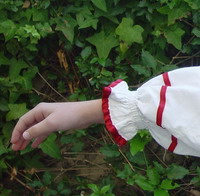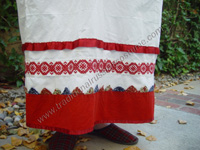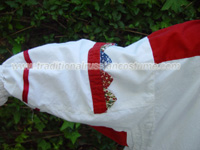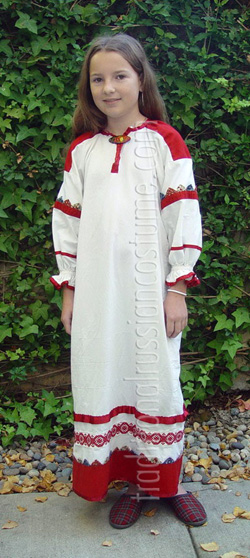|
This dress shows that the girl is not a child anymore.
All village children (both boys and girls) under approximately 8 years old
supposed to wear long pure white dresses (shirts), often made of second-hand cloths of their parents and elder siblings. Girls didn't wear skirts, boys didn't wear pants. As usual, there were two explanations: practical and spiritual. From practical point of view, everything is clear: a child grows fast (on the one hand), and (on the other hand) he/she wears his/her clothes carelessly - so there is no point to make child's costume of any expensive cloth, or to decorate it with hard-to-make (handmade!) embroidery. Spiritually, a child is innocent, and Heaven's white light shines above he/she yet. So, his/her costume suppose to be
pure white, with no any marks of an earth's life.
Around the age of 8, a child changed social category from kid to "otrok" (pre-teen). This transition was reflicted in his/her costume. Boys got their first pants and "grown-up-like" hats. For girls there was a special ritual called "Jumping Into a Skirt". But, girls "jumped into a skirt" only symbolically, they didn't get real skirt or sarafan (adult woman's dress) at that age. They simply started to wear fancier version of kid's dress (see photo).
NB ! on this picture the girl has no any
WAISTBAND. It is absolutely wrong (sorry).
 This dress has so-called "northen" silhouette: rectangular "paliki" (red shoulder details), red "lastovica" (armpit details), and red
protective "fire" trim around neck, wrists, and bottom. At this age shoulder details of girls' dresses were simply red, not embroidered ones yet. However, cuffs already had a small decorative frill (a predecessor of young women's splendid cuffs, decorated with lace and beads).
This dress has so-called "northen" silhouette: rectangular "paliki" (red shoulder details), red "lastovica" (armpit details), and red
protective "fire" trim around neck, wrists, and bottom. At this age shoulder details of girls' dresses were simply red, not embroidered ones yet. However, cuffs already had a small decorative frill (a predecessor of young women's splendid cuffs, decorated with lace and beads).
The dress as a whole is decorated with lots of magical details. Those details enforce maturation of "bride-will-be", and, also, protect her from any type of spiritual agression.

 The bottom of the dress is red. Traditionally, red color symbolizes blood, vitality, and woman's maturity. Mother Earth is the owner of woman's matutiry and fertility, so the red bottom part of the dress suppose to "ask Mother Earth" to give these powers to a certain girl. Triangles of different colors at the bottom and sleeves are, strictly speaking, arrows which show an energy flow direction (in this case - from Mother Earth to the girl, in contrast with
ritual harvesting dresses, where arrows point down - from a woman to Mother Earth).
The bottom of the dress is red. Traditionally, red color symbolizes blood, vitality, and woman's maturity. Mother Earth is the owner of woman's matutiry and fertility, so the red bottom part of the dress suppose to "ask Mother Earth" to give these powers to a certain girl. Triangles of different colors at the bottom and sleeves are, strictly speaking, arrows which show an energy flow direction (in this case - from Mother Earth to the girl, in contrast with
ritual harvesting dresses, where arrows point down - from a woman to Mother Earth).
 Besides, these triangles symbolize plants and flowers, so this detail could be understand like the incantation:
"Oh
Ladies of Fertility, please let my daughter bloom as flowers bloom in a springtime, let my daughter become mature as wheat is ripe in a summertime".
Besides, these triangles symbolize plants and flowers, so this detail could be understand like the incantation:
"Oh
Ladies of Fertility, please let my daughter bloom as flowers bloom in a springtime, let my daughter become mature as wheat is ripe in a summertime".
 However, according to traditional beliefs, Earth is not only Mother of the Harvest. She (I cannot say "it" in this context) also is a dwelling for dead bodies, and evil spirits. That's why it is not enough just to get an energy from Her. You need to filter out some non-desirable stuff. There are two "filters" on this dress. First, there is the embroidery line at the bottom. This design is not for the bottom especially. Sometimes people used it on woman's shirts' sleeves, or for
talismans. The meaning of this design is : "Seven powers of the world (Fire, Water, Earth, Air, Matter, Spirit, and Intelligence) bless you". Second filter is a red line above the enbroidery (the symbol is clear : if something bad could go through the embroidery, it would be burnt at this "fire line").
However, according to traditional beliefs, Earth is not only Mother of the Harvest. She (I cannot say "it" in this context) also is a dwelling for dead bodies, and evil spirits. That's why it is not enough just to get an energy from Her. You need to filter out some non-desirable stuff. There are two "filters" on this dress. First, there is the embroidery line at the bottom. This design is not for the bottom especially. Sometimes people used it on woman's shirts' sleeves, or for
talismans. The meaning of this design is : "Seven powers of the world (Fire, Water, Earth, Air, Matter, Spirit, and Intelligence) bless you". Second filter is a red line above the enbroidery (the symbol is clear : if something bad could go through the embroidery, it would be burnt at this "fire line").
|






